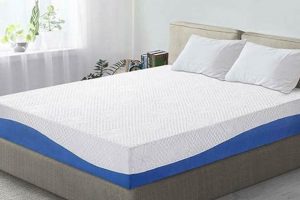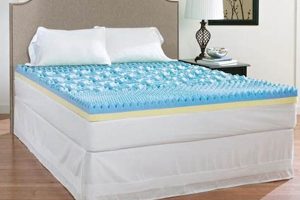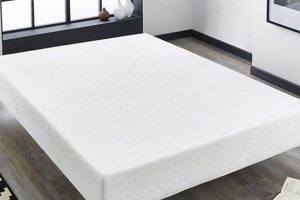Mattresses constructed with a particular type of viscoelastic polyurethane foam, characterized by a high concentration of material per unit volume, provide a distinct sleep surface. This construction results in a firmer feel and enhanced support compared to lower-density counterparts. For example, a mattress with a density rating of 5 pounds per cubic foot exhibits greater resistance to compression and deformation.
The significance of increased density lies in its correlation with durability, longevity, and enhanced pressure relief. Mattresses of this type tend to resist sagging and maintain their shape over extended periods. The increased support can contribute to improved spinal alignment and reduced pressure points, potentially alleviating discomfort for individuals with back pain or joint issues. Historically, advancements in foam technology have enabled the creation of increasingly dense and resilient materials for bedding applications.
Subsequent sections will explore the specific benefits of enhanced support and longevity in greater detail. Furthermore, the article will examine the factors influencing the selection of these mattresses, including density ratings, construction methods, and considerations for different sleep preferences. The article will conclude with guidance on proper maintenance and care to maximize the lifespan of these mattresses.
Maximizing the Benefits
The following recommendations are intended to ensure the longevity and performance of the sleep surface. Implementing these strategies can contribute to a more restful and supportive sleep experience.
Tip 1: Select an Appropriate Foundation: The foundation supporting the mattress should provide adequate and even support. Slatted foundations with narrow gaps may lead to uneven wear and premature degradation. A solid or closely-spaced slatted foundation is recommended.
Tip 2: Employ a Mattress Protector: A waterproof and breathable mattress protector shields the mattress from spills, stains, and dust mites. This preventative measure can significantly extend the lifespan and maintain hygiene.
Tip 3: Rotate Regularly: Rotating the mattress 180 degrees every three to six months helps to distribute wear evenly across the surface. This practice can prevent localized sagging and maintain consistent support.
Tip 4: Ensure Proper Ventilation: Adequate airflow around the mattress is essential to prevent moisture buildup and mold growth. Avoid placing the mattress directly on the floor or in excessively humid environments.
Tip 5: Adhere to Weight Restrictions: Exceeding the manufacturer’s recommended weight limits can compromise the structural integrity of the mattress and accelerate wear. Consult the product specifications for appropriate weight guidelines.
Tip 6: Vacuum Periodically: Regularly vacuuming the mattress surface removes dust, debris, and allergens. Use an upholstery attachment and low suction to avoid damaging the foam.
Tip 7: Spot Clean Stains Promptly: Address spills and stains immediately using a mild detergent and a clean cloth. Avoid harsh chemicals or excessive moisture, which can damage the foam.
Adhering to these guidelines will help preserve the mattress’s support characteristics and hygienic condition, resulting in a better return on investment and enhanced sleep quality.
The subsequent section will summarize the core attributes and benefits discussed throughout this discourse, reinforcing the value proposition offered.
1. Firmness and Support
The firmness and support characteristics exhibited by a mattress significantly impact sleep quality and musculoskeletal health. In the context of a high-density memory foam mattress, these attributes are intrinsically linked to the material’s composition and its ability to conform to and support the sleeper’s body.
- Density’s Influence on Firmness
Density directly correlates with firmness. A mattress with higher density material typically provides a firmer sleep surface. This firmness stems from the increased resistance to compression offered by the tightly packed foam cells. For instance, a 5 lb/cubic foot density foam will feel firmer and more supportive than a 3 lb/cubic foot density foam. The implication is that individuals seeking a more stable and less yielding sleep surface should consider mattresses with higher density ratings.
- Conformity and Spinal Alignment
Memory foam’s capacity to conform to the body’s contours contributes significantly to spinal alignment. High-density foam offers improved support by evenly distributing weight and minimizing pressure points. This conformity can promote a neutral spine position, reducing strain on the back and neck. Consider the difference between a hammock and a flat board: the hammock conforms but lacks support, while the board provides support but lacks conformity. A high-density memory foam mattress aims to strike a balance between these two extremes.
- Long-Term Support and Sag Resistance
The density of the memory foam is a crucial factor in determining its long-term support and resistance to sagging. High-density foam is less prone to compression over time, maintaining its structural integrity and support characteristics for a longer duration. Lower-density foams tend to break down more rapidly, leading to sagging and a loss of support. This is akin to the difference between a well-built bridge designed to withstand heavy traffic and a poorly constructed one prone to collapse.
- Weight Distribution and Pressure Relief
Effective weight distribution is crucial for pressure relief. High-density memory foam excels in this area by distributing the sleeper’s weight evenly across the mattress surface. This reduces pressure points in areas such as the shoulders and hips, potentially alleviating discomfort and promoting better circulation. Imagine standing on one foot versus standing on both feet; the pressure is significantly reduced when the weight is distributed across a larger area.
The interplay between density, conformity, and support dictates the overall feel and performance of a high-density memory foam mattress. While individual preferences vary, a mattress with appropriate firmness and support characteristics is essential for promoting healthy sleep posture and minimizing discomfort. Carefully evaluating these factors is paramount when selecting a mattress designed to meet specific needs and sleep requirements.
2. Enhanced Durability
Enhanced durability is a critical attribute directly influenced by the density of the foam. Mattresses manufactured using high-density memory foam exhibit a prolonged lifespan due to the material’s inherent resistance to compression and deformation. This resist
ance stems from the greater mass of material packed into a given volume, resulting in a more robust and resilient structure. The cause-and-effect relationship is straightforward: higher density leads to reduced material breakdown under sustained pressure, thereby extending the usable life of the mattress. The importance of this durability cannot be overstated, as mattresses represent a significant investment for consumers. A mattress that retains its support characteristics over a longer period provides superior value compared to those that degrade rapidly. Consider, for example, two mattresses subjected to identical usage over a five-year period. A lower-density mattress may exhibit noticeable sagging and a loss of support, necessitating replacement. Conversely, a mattress constructed with high-density memory foam is more likely to maintain its original shape and support, postponing the need for replacement and resulting in cost savings.
The increased durability of these mattresses also translates into greater consistency in sleep quality over time. As lower-density mattresses degrade, the support they provide diminishes, potentially leading to discomfort and disturbed sleep. A mattress that maintains its integrity provides a more stable and predictable sleep surface, contributing to better rest and overall well-being. Furthermore, the enhanced durability reduces the environmental impact associated with frequent mattress replacements. The disposal of old mattresses contributes to landfill waste, and minimizing the frequency of disposal is a desirable outcome from a sustainability perspective. The practical significance of understanding the link between density and durability lies in informing purchasing decisions. Consumers who prioritize longevity and consistent performance should prioritize mattresses constructed with high-density memory foam.
In conclusion, enhanced durability is a direct consequence of the high density, making them a lasting investment. This inherent longevity not only provides long-term cost savings but also contributes to consistent sleep quality and reduced environmental impact. While the initial cost of a high-density memory foam mattress may be higher than that of lower-density alternatives, the extended lifespan and sustained performance characteristics justify the investment for those seeking a durable and reliable sleep solution. The challenge lies in accurately assessing the density of a mattress, as manufacturers’ specifications may not always be transparent. However, prioritizing reputable brands and seeking detailed product information can help consumers make informed decisions and reap the benefits of enhanced durability.
3. Pressure Relief
Pressure relief is a fundamental characteristic exhibited by high-density memory foam mattresses. The ability to alleviate pressure points is pivotal in promoting comfortable sleep and reducing musculoskeletal discomfort. The viscoelastic properties of the foam, combined with its density, contribute to the effective distribution of weight, thereby minimizing concentrated pressure on specific areas of the body.
- Conforming Support and Pressure Redistribution
High-density memory foam conforms closely to the body’s contours, creating a cradle-like effect. This conformity allows the mattress to distribute weight evenly, rather than concentrating it on prominent areas like the shoulders, hips, and knees. The result is a reduction in pressure on these points, which can significantly alleviate pain and discomfort. For instance, individuals with arthritis or fibromyalgia often find relief from the pressure-reducing properties of this material, as it minimizes the strain on sensitive joints.
- Influence of Density on Pressure Alleviation
The density of the memory foam directly affects its ability to relieve pressure. Higher-density foams exhibit a greater resistance to compression, which translates to improved support and weight distribution. This means that they are less likely to “bottom out” under pressure, providing consistent support and preventing pressure points from developing. Low-density foams, conversely, compress more readily, potentially leading to increased pressure in areas where the body exerts the most force.
- Impact on Circulation and Sleep Quality
Reduced pressure points can improve blood circulation throughout the body. When pressure is concentrated on specific areas, it can restrict blood flow, leading to discomfort and restlessness. By distributing weight evenly, high-density memory foam promotes better circulation, potentially reducing tossing and turning and improving overall sleep quality. Individuals who experience numbness or tingling in their extremities may find that a high-density mattress provides relief by minimizing pressure on nerves and blood vessels.
- Comparison to Other Mattress Types
Compared to traditional innerspring mattresses, high-density memory foam generally offers superior pressure relief. Innerspring mattresses tend to have more localized support, which can create pressure points. Memory foam, with its conforming properties, provides more uniform support and minimizes pressure concentrations. While latex mattresses also offer pressure relief, their feel is typically firmer and more responsive than memory foam, which may not be preferred by all individuals.
The ability to alleviate pressure points makes them a suitable option for individuals seeking enhanced comfort and relief from musculoskeletal pain. The density of the foam is a critical factor in determining the effectiveness of this pressure relief, with higher densities generally providing superior support and weight distribution. When selecting a mattress, individuals should consider their specific needs and preferences to determine whether a high-density memory foam option is the best choice for promoting restful and pain-free sleep.
4. Temperature Sensitivity
Temperature sensitivity is an inherent characteristic of viscoelastic memory foam, and this property significantly influences the performance and user experience. High-density memory foam, due to its composition and structure, exhibits a noticeable response to temperature fluctuations. The cause-and-effect relationship is such that increased temperature softens the foam, enhancing its conforming ability, while decreased temperature stiffens the foam, reducing its pliability. The degree of temperature sensitivity is a critical factor determining the comfort and support provided by a mattress. For example, in warmer climates or during summer months, a memory foam mattress may feel softer and more enveloping than in cooler climates or during winter months. This variation in firmness can affect spinal alignment and pressure relief, potentially impacting sleep quality. The practical significance of understanding this property lies in allowing consumers to anticipate and potentially mitigate the effects of temperature on their sleep surface.
The interaction between body temperature and the foam is equally important. As a sleeper lies on the mattress, their body heat gradually warms the contact points, causing the foam to soften and mold to their shape. This process contributes to the pressure-relieving benefits and personalized comfort associated with memory foam. However, this same process can also lead to heat retention, a common complaint among some users. High-density foams, by virtue of
their increased mass, tend to retain more heat than lower-density foams. This can create a sensation of sleeping “hot,” particularly for individuals who are prone to night sweats or live in warmer environments. To counter this, manufacturers often incorporate cooling technologies such as gel infusions or open-cell structures designed to improve airflow and dissipate heat. These features aim to reduce the temperature sensitivity’s negative effects without compromising the foam’s inherent support and pressure-relieving qualities.
In summary, temperature sensitivity is an unavoidable characteristic of memory foam that has both positive and negative implications for sleep comfort. The enhanced conforming ability at warmer temperatures contributes to pressure relief and personalized support, while the potential for heat retention can lead to discomfort for some individuals. Addressing this challenge through innovative cooling technologies is an ongoing area of development in the mattress industry. The consumer’s understanding of this phenomenon enables a more informed purchasing decision, allowing for the selection of a mattress that best suits their individual temperature preferences and sleep environment. Mitigation strategies, such as using breathable bedding and regulating room temperature, can further optimize the sleep experience.
5. Motion Isolation
Motion isolation, a critical performance aspect of mattresses, is significantly influenced by the density and composition of the materials used in their construction. High-density memory foam mattresses, by virtue of their viscoelastic properties and substantial material concentration, excel in minimizing the transfer of movement across the sleep surface. The cause-and-effect relationship dictates that the denser the foam, the greater its capacity to absorb and dampen motion energy. This characteristic is of particular importance for couples sharing a bed, as it reduces the likelihood of one partner’s movements disturbing the other’s sleep. Consider a scenario where one partner frequently tosses and turns during the night. On a traditional innerspring mattress, these movements would likely be transmitted across the entire surface, potentially awakening or disrupting the sleep of the other partner. A high-density memory foam mattress, however, absorbs much of this motion energy, preventing it from propagating across the bed and minimizing disturbance. The practical significance of this lies in improved sleep quality and reduced sleep fragmentation for both partners.
The effectiveness of motion isolation is not solely dependent on the density of the memory foam but also on the overall construction of the mattress. Mattresses combining high-density memory foam with other layers, such as support cores made of high-density polyfoam or individually pocketed coils, can further enhance motion isolation. These additional layers contribute to the absorption and dissipation of motion energy, resulting in a more stable and undisturbed sleep surface. For example, a mattress incorporating a layer of high-density memory foam over a base of individually pocketed coils would provide both excellent contouring and minimal motion transfer. In practical terms, this type of construction would be well-suited for individuals with differing sleep schedules or those who are particularly sensitive to movement during the night. The ability to isolate motion is also relevant for individuals who share a bed with pets, as their movements are less likely to cause widespread disturbance.
In summary, motion isolation is a key attribute of high-density memory foam mattresses, directly related to their ability to absorb and dampen movement energy. This characteristic is crucial for minimizing sleep disturbances and improving sleep quality, particularly for couples sharing a bed. While density is a primary factor influencing motion isolation, the overall construction of the mattress, including the use of additional layers such as pocketed coils, can further enhance this performance aspect. The challenge lies in accurately assessing the motion isolation capabilities of a mattress prior to purchase, as subjective testing may be necessary to fully appreciate the benefits. However, prioritizing mattresses constructed with high-density memory foam and incorporating additional motion-isolating features can significantly improve the sleep experience for those sensitive to movement.
Frequently Asked Questions
The following questions address common inquiries regarding high-density memory foam mattresses, providing clarity on their properties, benefits, and limitations.
Question 1: What constitutes “high density” in the context of memory foam?
Density, in this context, refers to the weight of the memory foam material per unit volume, typically measured in pounds per cubic foot (lbs/ft). Mattresses with a density of 5 lbs/ft or higher are generally considered high density. This metric indicates the material’s robustness and potential for long-term durability.
Question 2: Does a higher density always equate to a superior mattress?
While high density generally correlates with increased durability and support, it does not automatically guarantee a superior mattress. Individual comfort preferences, desired firmness levels, and specific needs, such as spinal alignment or pressure relief, must also be considered. A mattress should align with individual sleep needs.
Question 3: Are high-density memory foam mattresses prone to overheating?
High-density memory foam can retain more heat than lower-density alternatives due to its reduced airflow. However, manufacturers often incorporate cooling technologies, such as gel infusions or open-cell structures, to mitigate this issue. The effectiveness of these technologies varies.
Question 4: How does a mattress impact motion isolation?
Mattresses constructed with high-density memory foam generally provide superior motion isolation compared to traditional innerspring mattresses. The foam’s viscoelastic properties absorb movement, minimizing the transfer of motion across the sleep surface. This is an important consideration for couples.
Question 5: What is the expected lifespan of a mattress?
The lifespan is influenced by several factors, including density, usage patterns, and maintenance practices. High-density mattresses typically last longer than lower-density options, with an average lifespan ranging from seven to ten years with proper care.
Question 6: Are there any potential drawbacks to consider?
Potential drawbacks include a higher initial cost, the potential for increased heat retention, and a firmer feel compared to lower-density memory foam. Individuals should weigh these considerations against the benefits of enhanced durability and support. Careful evaluation is recommended.
In summary, it offers enhanced durability, support, and motion isolation, but also presents potential drawbacks such as higher cost and heat retention. Individual needs and preferences should guide the selection process.
The following section will provide guidance on selecting a mattress to align with individual needs and preferences.
High Density Memory Foam Mattress
This discourse has explored the multifaceted characteristics of the high density memory foam mattress, underscoring its enhanced durability, support capabilities, pressure relief potential, and motion isolation effectiveness. While temperature sensitivity and initial cost present considerations, the analysis reveals a material composition designed for longevi
ty and sustained performance. A thorough understanding of these attributes is crucial for informed consumer decision-making, balancing potential drawbacks against the demonstrated benefits.
The selection of a sleep surface represents a significant investment in personal well-being. Continued advancements in foam technology and construction methods hold the promise of further refining the properties of high density memory foam, potentially addressing existing limitations and expanding its applicability across diverse sleep preferences and physical needs. Careful consideration of individual requirements, coupled with a comprehensive understanding of material properties, remains paramount in optimizing the sleep experience.







